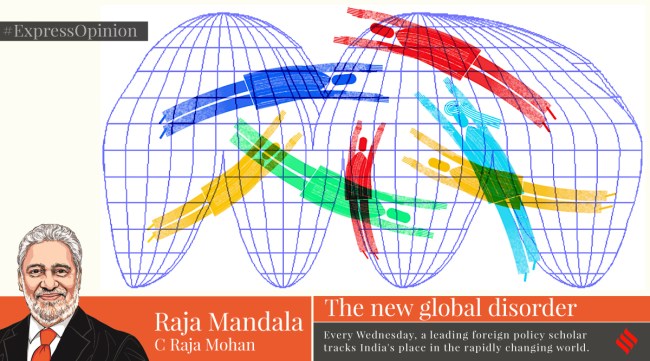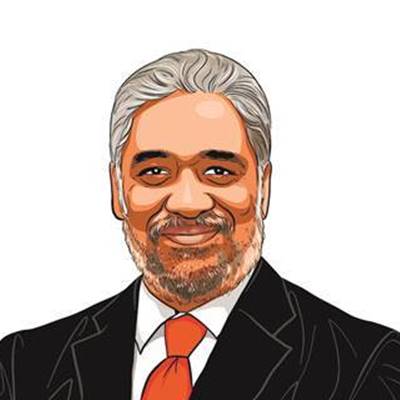Opinion C Raja Mohan writes: Japanese PM Kishida’s visit to India, Chinese president Xi’s trip to Moscow, and the rearrangement of great power and regional politics
C Raja Mohan writes: The stage is set for a restructuring of Delhi’s geopolitics, as the rules governing the world that emerged at the end of the Cold War come under escalating stress
 Prime Minister Narendra Modi with Japanese PM Fumio Kishida at Buddha Jayanti Park, in New Delhi. (PTI)
Prime Minister Narendra Modi with Japanese PM Fumio Kishida at Buddha Jayanti Park, in New Delhi. (PTI) Visiting Japanese Prime Minister Fumio Kishida’s ambition to elevate the Indo-Pacific partnership with India and Chinese President Xi Jinping’s visit to Moscow this week to consolidate the Eurasian alliance with the Russian leader Vladimir Putin are two elements of the unfolding geopolitical churn.
Beyond the great power realignment, there is also a recalibration of relations among major middle powers. Last week, to the west of India, we saw the unveiling of a thaw between the two long-time rivals — Iran and Saudi Arabia — at a ceremony in Beijing. Less noticed in India was an even more consequential development to the east — the first summit in nearly twelve years between the leaders of two major global economies and neighbours — South Korea and Japan.
If the Saudi-Iran entente was widely hailed as a diplomatic triumph for Beijing and a setback for Washington, ending the prolonged political chill between Seoul and Tokyo is being hailed as a major diplomatic win for the US and a big loss for China, which had been teasing South Korea away from the US and Japan in recent years. The US has made other gains on China’s periphery. It has managed to win the confidence of the new Philippines president Bongbong Marcos. The Philippines is an old treaty ally of the US that was drifting towards China under Marcos’s immediate predecessor, Rodrigo Duterte.
Equally interesting is the agreement between Germany and Japan last week to coordinate their policies on Russia and reduce their excessive dependence on China-centred supply chains. If you thought Europe and Asia are twains that shall never meet you could not be more mistaken today as the separation between the two theatres begins to break down.
The current dynamism in major power relations reminds us of Mao Zedong’s oft-repeated quote — “there is great disorder under the heavens. The situation is excellent”. Although Mao’s remarks were about China’s chaotic domestic situation in the 1960s, they could well describe the current international situation.
The realignment and dealignment underway is very much part of the emerging post-post-Cold War world. The rules governing the world that emerged at the end of the Cold War during 1989-91 have been under stress for a while now. The Russian aggression against Ukraine and the deepening conflict over Taiwan have accelerated the breakdown. The conflict envelops the economic and technological domains as well.
All countries, including India, are adapting to the breakdown of the old order at different speeds and with varying senses of urgency. In the scramble for a rearrangement of great power and regional politics, some trends are enduring and others are about short-term adjustments.
In the Middle East, the Saudi-Iran rapprochement could be seen as either tactical or strategic. If you are a sceptic, you might say one photo-op in Beijing is not going to overcome the deep contradictions between Saudi Arabia and Iran. You might also add that Saudis will find it hard to break up their hundred-year-old partnership with the Anglo-American powers. If you are a realist, you might note that the effort to limit the conflict between Iran and Saudi Arabia is not an exception in the Middle East. The conflict between UAE and Saudi Arabia on the one hand and Qatar on the other was patched up in 2021. Turkey’s Recep Tayyip Erdogan is now trying to end his political rift with Saudi Arabia and Egypt.
Turkey and Iran face deepening domestic crises and have every reason to scale down their foreign policy adventurism of recent decades. Saudi Arabia and the UAE, which backed total US confrontation with Iran under Trump, are not so sure about Biden’s policies and are finding it wise to temper their conflict with Tehran. Meanwhile, the sharpening contradictions between Russia and China on the one hand and the West on the other, have given regional powers some room for bargaining with both sides. There are so many moving parts to this big picture, what we see today need not necessarily be what we might find tomorrow.
Consider the volatile domestic politics of South Korea. It is not clear if the current bold policies of President Yoon Suk-yeol, of befriending Japan and warming up to the US’s regional strategies will be sustained by the next president. Nor can South Korea’s deep economic relationship with China be overturned in the immediate future.
The shifting regional dynamic to the east and west of India demands an Indian diplomacy that is nimble, flexible and open-ended. More demanding on Delhi, however, is the profound transformation of the partnership between Russia and China. Since he became China’s leader, Xi Jinping has met Putin more than three dozen times. This week’s trip to Moscow will be Xi’s first since the Russian invasion of Ukraine and his re-election as China’s president for an unprecedented third term.
The expectations from the visit are running high as both Xi and Putin have talked up the visit in signed articles for Russian and Chinese media respectively. There is speculation that Xi might try and promote a peace settlement between Moscow and Kyiv.
Others suggest something else — Xi might choose to reinforce Putin’s position while talking about peace in Ukraine. Cynical observers say Moscow has done Beijing a great favour by tying down the West into a conflict with Russia in Europe, thereby easing the US pressure on China in Asia. Xi, the argument goes, has a huge stake in bolstering Putin.
Beyond China’s position on Ukraine peace, the long-term concern for Delhi is Putin’s growing dependence on Xi. There are at least three ways of looking at it from India. One view is that a weakened Russia will inevitably become a junior partner to China thereby making Moscow a less reliable partner for Delhi in balancing Beijing.
A second position argues that Russia-India relations are essentially immune to change. It insists Russia will always be an independent great power and that Moscow can keep the ties with Beijing and Delhi on separate tracks despite the growing Sino-Indian contradictions and deepening strategic bonds between Russia and China.
A third view is less sanguine about the future of the Sino-Russian partnership and would hedge against the worst possible outcomes for India in relation to China. Might this involve building stronger strategic ties with the US, Europe and Japan? This basic direction has been set over the last decade even as Delhi has held onto its old ties to Moscow. The next few weeks might give us some clues on how India might navigate the turbulence in great power relations.
In May, Modi will travel to Tokyo to attend the G7 meeting and to Canberra to participate in the Quad summit. The PM is expected to travel to Washington for a state visit later in the summer. Delhi will also have a chance to host both Putin and Xi twice over in the coming months for the SCO and G20 summits. The stage then is set for a potential restructuring of India’s geopolitics in a rapidly changing world.
The writer is, senior fellow, Asia Society Policy Institute and contributing editor on international affairs for The Indian Express





